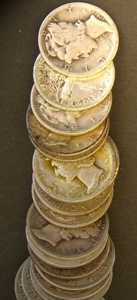The Sheldon Scale rates from 1 to 70. Despite repeated arguments by the large Third Party Grading services (TPG) to change to a 100 point scale, Sheldon’s grading scale has lasted the test of time.
Mint State (Uncirculated) - MS 60-70: Absolutely no trace of wear.
.jpg)
1935-s Mint State 62 Mercury Dime Graded by NGC (Obverse)
 (Small).jpg)
1935-S Mint State 62 Mercury Dime Graded by NGC (reverse)
Almost Uncirculated - AU 50- 58: Small trace of wear visible on the highest design points.
.jpg)
1939-D AU 58 Mercury Dime (Obverse)
.jpg)
1939-D AU 58 Mercury Dime (Reverse)
Extremely Fine - XF or EF 40-48: Very light wear on only the highest points.
Very Fine - VF 20-30: Light to medium wear. All major features are sharp.
Fine - F12-18: Moderate to heavy even wear. Entire design clear and bold.
Very Good - VG 8-11: Well worn. Design clear, but flat and lacking details.
Good - G 4-7: Heavily worn. Design and legend visible but faint in spots.
Almost Good - AG 3: Outlined design. Parts of date and legend worn smooth.
Fair - F 2: You can identify the coin as to its type
Poor - P 1: You can identify the coin's general metal type.
Basal State - Basal 0: You can identify the lump of metal as being a coin.
Coin grading is part art and part science. Often a coin could easily go on of two ways, especially in the higher grades such as Mint State (MS) 64 and 65 where there is just one point difference. A general approach that third party graders (TPG’s) use is to have the coin graded by one grader to determine that a coin is gradable (not damaged, counterfeit, altered surfaces etc) and then by two more graders each independent of each other. Then the three grades are merged to get an average. Their accuracy usually will reach the 90 percentile range.
Coin grades are basically opinions and there are many things that drive the grading standards. Coin rarity and demand are two things that drive the grade. A high quality rare coin may be scrutinized very carefully thus ensuring the coin meets the standards for that grade beyond any reasonable doubt. A coin that is high in demand may be pushed to the higher grade if it is borderline. (For circulated grades only). This is known as market grade or market acceptable. Mint state coins in high demand are actually graded more rigorously because of the price differences between the grades.
Eye appeal, strike, luster, surface marks and toning are the five major grading factors. The first and most important is the overall appearance of the coin. An experienced coin grader looks at the entire coin from half an arm's length distance to gauge the entire package as a first impression. This allows the grader to formulate an immediate feel for the coin and observe the luster and other less tangible factors that create a pleasing appearance to the naked human eye.

